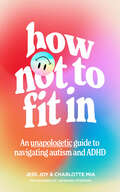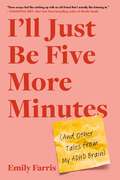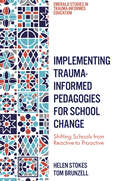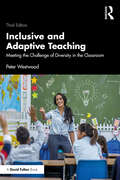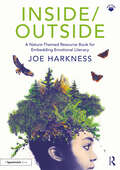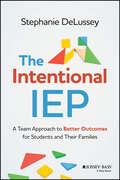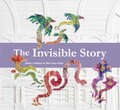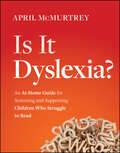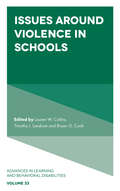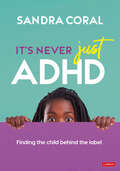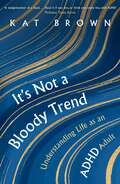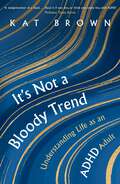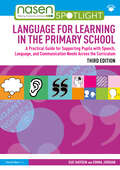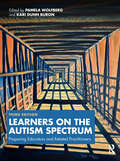- Table View
- List View
How Not to Fit In: An Unapologetic Guide To Navigating Autism And Adhd
by Jess Joy Charlotte Mia’The lack of information around how ADHD and autism shows up in adults means that many of us have been assuming we were anxious, not working hard enough, or just entirely failing altogether.’ – Jess Joy and Charlotte Mia
I'll Just Be Five More Minutes: And Other Tales from My ADHD Brain
by Emily FarrisA hilariously-honest, heartwarming essay collection about life, love, and discovering you have ADHD at age 35 Despite being a published writer with a family, a gaggle of internet fans, and (most shockingly) a mortgage, Emily Farris could never get her sh*t together. As she saw it, disorganization was one of her countless character flaws—that is until she was diagnosed with ADHD at age 35. Like many girls who go undiagnosed, Emily grew up internalizing criticisms about her impulsivity and lack of follow-through. She held onto that shame as she tried (and often failed) to fit into a world designed for neurotypical brains. I'll Just Be Five More Minutes is a personal essay collection of laugh-out-loud-funny, tear-jerking, and at times cringey true stories of Emily's experiences as a neurodivergent woman. With the newfound knowledge of her ADHD, Emily candidly reexamines her complicated relationships (including one with a celebrity stalker), her money problems, the years she spent unknowingly self-medicating, and her hyperfixations (two words: decorative baskets). A memoir-in-essays both entertaining and enlightening, I'll Just Be Five More Minutes is for people with ADHD, as well as those who know and love them. This is a powerful collection of deeply relatable, wide-ranging stories about a woman's right to control her own body, about overwhelm and oversharing, about drinking too much and sleeping too little, and about being misunderstood by the people closest to you. At its heart, I&’ll Just Be Five More Minutes is about not quite fitting in and not really understanding why—something we&’ve all felt whether we're neurodivergent or not.
Implementing Trauma-Informed Pedagogies for School Change: Shifting Schools from Reactive to Proactive (Emerald Studies in Trauma-Informed Education)
by Helen Stokes Tom BrunzellThe area of trauma-informed positive education (TIPE) is a recently emerging field in educational studies. Schools serving communities contending with educational inequity have many students identified as trauma-affected, with significant unmet learning and social emotional needs. This groundbreaking study and first book in the Emerald Studies in Trauma-Informed Education series is the first longitudinal research in trauma informed positive education, and the first research to link the professional learning and ongoing implementation of TIPE pedagogical practices to changed student perceptions of school and collective teacher efficacy over a four-year period. Providing examples of how schools implement TIPE and using case studies from two schools that were experiencing difficulty with their delivery of learning and wellbeing outcomes for students, the authors explore how implementing TIPE pedagogical practices can bring about school change. There is a focus on student wellbeing, collective teacher efficacy and assisting students to be ready to learn. The case studies that are explored will be of interest to school practitioners and system leaders working with students who are are not yet ready to learn and disengaged from school.
Implementing Trauma-Informed Pedagogies for School Change: Shifting Schools from Reactive to Proactive (Emerald Studies in Trauma-Informed Education)
by Helen Stokes Tom BrunzellThe area of trauma-informed positive education (TIPE) is a recently emerging field in educational studies. Schools serving communities contending with educational inequity have many students identified as trauma-affected, with significant unmet learning and social emotional needs. This groundbreaking study and first book in the Emerald Studies in Trauma-Informed Education series is the first longitudinal research in trauma informed positive education, and the first research to link the professional learning and ongoing implementation of TIPE pedagogical practices to changed student perceptions of school and collective teacher efficacy over a four-year period. Providing examples of how schools implement TIPE and using case studies from two schools that were experiencing difficulty with their delivery of learning and wellbeing outcomes for students, the authors explore how implementing TIPE pedagogical practices can bring about school change. There is a focus on student wellbeing, collective teacher efficacy and assisting students to be ready to learn. The case studies that are explored will be of interest to school practitioners and system leaders working with students who are are not yet ready to learn and disengaged from school.
Inclusive and Adaptive Teaching: Meeting the Challenge of Diversity in the Classroom
by Peter WestwoodThis new edition of Inclusive and Adaptive Teaching from bestselling author Peter Westwood continues to provide a range of practical strategies for advancing the learning and development of all students in inclusive classrooms. Drawing on the most recent international research into teaching methods, Westwood presents a range of evidence-based strategies for adapting curriculum content, modifying learning activities and resources, and for making any necessary accommodations during assessment. Revised topics in this third edition include a focus on the implications of diversity and exceptionality, the progress made to date in providing inclusive schooling, a presentation of evidence-based methods for teaching mixed-ability classes and ideas for adapting the curriculum and designing teaching materials. New topics in this revised edition include: • how to support students’ self-determination and autonomy; • LGBTQ+ issues for inclusive schools; • the UK ‘engagement model’ for assessing very low-functioning children; • the concept and purposes of a ‘flipped classroom’; • engaging with a Response-to-Intervention Model; • how to support students in vocational colleges and universities. Each chapter contains an up-to-date list of online and print resources available to teachers who wish to pursue topics in greater depth. This text is an invaluable resource for both practicing and trainee teachers and teaching assistants, as well as school principals, school counsellors and educational psychologists.
Inclusive and Adaptive Teaching: Meeting the Challenge of Diversity in the Classroom
by Peter WestwoodThis new edition of Inclusive and Adaptive Teaching from bestselling author Peter Westwood continues to provide a range of practical strategies for advancing the learning and development of all students in inclusive classrooms. Drawing on the most recent international research into teaching methods, Westwood presents a range of evidence-based strategies for adapting curriculum content, modifying learning activities and resources, and for making any necessary accommodations during assessment. Revised topics in this third edition include a focus on the implications of diversity and exceptionality, the progress made to date in providing inclusive schooling, a presentation of evidence-based methods for teaching mixed-ability classes and ideas for adapting the curriculum and designing teaching materials. New topics in this revised edition include: • how to support students’ self-determination and autonomy; • LGBTQ+ issues for inclusive schools; • the UK ‘engagement model’ for assessing very low-functioning children; • the concept and purposes of a ‘flipped classroom’; • engaging with a Response-to-Intervention Model; • how to support students in vocational colleges and universities. Each chapter contains an up-to-date list of online and print resources available to teachers who wish to pursue topics in greater depth. This text is an invaluable resource for both practicing and trainee teachers and teaching assistants, as well as school principals, school counsellors and educational psychologists.
Inside/Outside: A Nature-Themed Resource Book for Embedding Emotional Literacy
by Joe HarknessInside/Outside is a unique educational resource for those working with young people of secondary school age, providing a variety of tried-and-tested indoor and outdoor lessons and activities to promote and embed emotional literacy. The book is divided into three accessible sections: emotions and feelings; self and situation; and mental health and wellbeing; which each cover a variety of themes, from anxiety and depression, to happiness, communication, and confidence. For each theme, ‘inside’ and ‘outside’ activities are offered, with inside activities inspiring students to self-reflect and develop empathy for others, and those outside drawing heavily on nature and learning outside the classroom. The ‘outside’ activities are adaptable and have been designed to work in any available outdoor space, and all activities can be used either in standalone lessons or sequentially, with introductory tasks, group activities, and circle time discussions. With a focus on equipping students with meaningful and tangible skills to support them in the recognition, identification, and expression of their emotions, Inside/Outside will be a valuable resource for teachers, youth workers, home-educators and anyone else looking to facilitate nature connection and introspection in children aged eleven to sixteen.
Inside/Outside: A Nature-Themed Resource Book for Embedding Emotional Literacy
by Joe HarknessInside/Outside is a unique educational resource for those working with young people of secondary school age, providing a variety of tried-and-tested indoor and outdoor lessons and activities to promote and embed emotional literacy. The book is divided into three accessible sections: emotions and feelings; self and situation; and mental health and wellbeing; which each cover a variety of themes, from anxiety and depression, to happiness, communication, and confidence. For each theme, ‘inside’ and ‘outside’ activities are offered, with inside activities inspiring students to self-reflect and develop empathy for others, and those outside drawing heavily on nature and learning outside the classroom. The ‘outside’ activities are adaptable and have been designed to work in any available outdoor space, and all activities can be used either in standalone lessons or sequentially, with introductory tasks, group activities, and circle time discussions. With a focus on equipping students with meaningful and tangible skills to support them in the recognition, identification, and expression of their emotions, Inside/Outside will be a valuable resource for teachers, youth workers, home-educators and anyone else looking to facilitate nature connection and introspection in children aged eleven to sixteen.
The Intentional IEP: A Team Approach to Better Outcomes for Students and Their Families
by Stephanie DeLusseyLearn how to put together IEPs with the power to make a real difference for students The Intentional IEP shows special education teachers how to successfully collaborate with all stakeholders—parents or guardians, general ed teachers, therapists, and beyond—to work toward students’ success. Too many of us aren’t trained to write the Individualized Education Programs that help millions of students with thrive in school. This book fills that training gap, explaining the importance of assembling an IEP team and inviting this team to confront and improve its current processes and habits to make IEP writing simpler and more effective. With all the pressures that educators are under, it’s easy to cut corners when it comes time towrite IEPs. Writing them in isolation, leaving them to the night before, making decisions without consulting data and research, letting family collaboration fall to the wayside—most special educators have made these mistakes at some point. The Intentional IEP equips you with the resources you need to feel confident in approaching IEPs the right way, including prioritizing the many competing demands you face so you can find the capacity to show up for your students. This book offers: Clear, step-by-step solutions for all IEP members that can easily be implemented at any time during the school year Collaboration strategies for IEP teammates to rely on one another for expert and professional knowledge Tools and reproducibles to strengthen practices and overcome common hurdles Direct advice from a veteran special education teacher who has seen what a difference collaboration in the IEP can make for studentsThe Intentional IEP is a timely resource for special education teachers, general education teachers, and support staff, as well as teachertraining programs. Parents and guardians with students will also benefit from this clearly written guide to the IEP.
The Intentional IEP: A Team Approach to Better Outcomes for Students and Their Families
by Stephanie DeLusseyLearn how to put together IEPs with the power to make a real difference for students The Intentional IEP shows special education teachers how to successfully collaborate with all stakeholders—parents or guardians, general ed teachers, therapists, and beyond—to work toward students’ success. Too many of us aren’t trained to write the Individualized Education Programs that help millions of students with thrive in school. This book fills that training gap, explaining the importance of assembling an IEP team and inviting this team to confront and improve its current processes and habits to make IEP writing simpler and more effective. With all the pressures that educators are under, it’s easy to cut corners when it comes time towrite IEPs. Writing them in isolation, leaving them to the night before, making decisions without consulting data and research, letting family collaboration fall to the wayside—most special educators have made these mistakes at some point. The Intentional IEP equips you with the resources you need to feel confident in approaching IEPs the right way, including prioritizing the many competing demands you face so you can find the capacity to show up for your students. This book offers: Clear, step-by-step solutions for all IEP members that can easily be implemented at any time during the school year Collaboration strategies for IEP teammates to rely on one another for expert and professional knowledge Tools and reproducibles to strengthen practices and overcome common hurdles Direct advice from a veteran special education teacher who has seen what a difference collaboration in the IEP can make for studentsThe Intentional IEP is a timely resource for special education teachers, general education teachers, and support staff, as well as teachertraining programs. Parents and guardians with students will also benefit from this clearly written guide to the IEP.
The Invisible Story
by Jaime GamboaThe world is full of stories. Some are as long as lizards, others so short that they never even make it to The End. But the invisible story is unlike any other story because no one has ever read it! It lives hidden in the darkest corner of the library, far from where the famous tales, written in gold letters, shine. One day, a blind reader approaches the story’s trembling pages. This reader is unlike any reader the invisible story has ever encountered. And when she runs her fingertips over the book’s white pages, it is astonished by what she finds. A beautifully inclusive tale about sight-loss in which we learn that not all stories are meant to be read with the eyes.
The Invisible Story
by Jaime GamboaThe world is full of stories. Some are as long as lizards, others so short that they never even make it to The End. But the invisible story is unlike any other story because no one has ever read it! It lives hidden in the darkest corner of the library, far from where the famous tales, written in gold letters, shine. One day, a blind reader approaches the story’s trembling pages. This reader is unlike any reader the invisible story has ever encountered. And when she runs her fingertips over the book’s white pages, it is astonished by what she finds. A beautifully inclusive tale about sight-loss in which we learn that not all stories are meant to be read with the eyes.
Is It Dyslexia?: An At-Home Guide for Screening and Supporting Children Who Struggle to Read
by April McMurtreyHands-on resources for screening readers of all ages for dyslexia In Is It Dyslexia?, certified dyslexia assessment specialist April McMurtrey delivers an accessible, hands-on framework for screening readers of various ages for dyslexia.. The book offers comprehensive, clear, and step-by-step processes you can apply immediately to confidently and accurately screen readersfor dyslexia. The author shares the tools and strategies used by professional screeners, as well as first, next, and final steps you can take as you move forward with your screening results. The book includes: Explanations of what dyslexia is, as well as an overview of common talents and strengths often found in readers with dyslexia A collection of recommended accommodations for students with dyslexia in the home and school and effective literacy instruction for students with dyslexia A comprehensive dyslexia questionnaire, eleven different screening tests, and step-by-step instructions for administering themIdeal for tutors, homeschool teachers, parents, instructional coaches, counselors, and speech-language therapists, Is It Dyslexia? comes complete with reproducibles and links to video tutorials required for screening students of various ages.
Is It Dyslexia?: An At-Home Guide for Screening and Supporting Children Who Struggle to Read
by April McMurtreyHands-on resources for screening readers of all ages for dyslexia In Is It Dyslexia?, certified dyslexia assessment specialist April McMurtrey delivers an accessible, hands-on framework for screening readers of various ages for dyslexia.. The book offers comprehensive, clear, and step-by-step processes you can apply immediately to confidently and accurately screen readersfor dyslexia. The author shares the tools and strategies used by professional screeners, as well as first, next, and final steps you can take as you move forward with your screening results. The book includes: Explanations of what dyslexia is, as well as an overview of common talents and strengths often found in readers with dyslexia A collection of recommended accommodations for students with dyslexia in the home and school and effective literacy instruction for students with dyslexia A comprehensive dyslexia questionnaire, eleven different screening tests, and step-by-step instructions for administering themIdeal for tutors, homeschool teachers, parents, instructional coaches, counselors, and speech-language therapists, Is It Dyslexia? comes complete with reproducibles and links to video tutorials required for screening students of various ages.
Issues Around Violence in Schools (Advances in Learning and Behavioral Disabilities #33)
by LAUREN W. COLLINS, TIMOTHY J. LANDRUM AND BRYAN G. COOKIt is challenging to understand the complexity and multiple causes of school violence. Given the apparent rise in many forms of violence in schools, and the dire consequences to those impacted by violence, it is vital to better support children and youth in both preventing violence and responding appropriately. Issues Around Violence in Schools explores a number of topics related to violence that occurs in schools or with school-aged children and youth. Authors address the nature and extent of violence in schools – including mass shootings but also other forms of violence – and the relationships and intersections among mental health, special education, and school violence in general. They consider positive approaches to mental health, behavior, and overall climate in schools, analysing both disciplinary practices and interventions and supports and their relationship to school violence. Key insights are presented regarding bullying, positive approaches to behavioral and social/emotional concerns, and the promise of threat assessment for mitigating violence and connecting students to needed supports. This volume provides an overview of key areas of promise for improved research and practice, such that schools are better positioned to mitigate violence, and to respond in positive, supportive ways to those who may be impacted by violence.
Issues Around Violence in Schools (Advances in Learning and Behavioral Disabilities #33)
by Lauren W. Collins Timothy J. Landrum Bryan G. CookIt is challenging to understand the complexity and multiple causes of school violence. Given the apparent rise in many forms of violence in schools, and the dire consequences to those impacted by violence, it is vital to better support children and youth in both preventing violence and responding appropriately. Issues Around Violence in Schools explores a number of topics related to violence that occurs in schools or with school-aged children and youth. Authors address the nature and extent of violence in schools – including mass shootings but also other forms of violence – and the relationships and intersections among mental health, special education, and school violence in general. They consider positive approaches to mental health, behavior, and overall climate in schools, analysing both disciplinary practices and interventions and supports and their relationship to school violence. Key insights are presented regarding bullying, positive approaches to behavioral and social/emotional concerns, and the promise of threat assessment for mitigating violence and connecting students to needed supports. This volume provides an overview of key areas of promise for improved research and practice, such that schools are better positioned to mitigate violence, and to respond in positive, supportive ways to those who may be impacted by violence.
It’s Never Just ADHD: Finding the Child Behind the Label
by Sandra CoralWe are never just a label, much like a child with ADHD is never just an ADHD child either. Labels often encourage us to interpret and define our students′ behaviours through the narrow lens of the dominant culture. A culture that encourages conformity and places blame on the individual when they can’t or won’t comply with its expectations. Drawing from lived experience and expertise educational consultant and host of Neurodivergent Narratives Podcast, Sandra Coral, offers educators a resource that will help widen the lens for understanding students with ADHD. It’s also not just a book about ADHD symptoms, strategies, and accommodations either. It’s so much more than that, much like the ADHD children that you know, care about, and work with every day.
It’s Never Just ADHD: Finding the Child Behind the Label
by Sandra CoralWe are never just a label, much like a child with ADHD is never just an ADHD child either. Labels often encourage us to interpret and define our students′ behaviours through the narrow lens of the dominant culture. A culture that encourages conformity and places blame on the individual when they can’t or won’t comply with its expectations. Drawing from lived experience and expertise educational consultant and host of Neurodivergent Narratives Podcast, Sandra Coral, offers educators a resource that will help widen the lens for understanding students with ADHD. It’s also not just a book about ADHD symptoms, strategies, and accommodations either. It’s so much more than that, much like the ADHD children that you know, care about, and work with every day.
It’s Never Just ADHD: Finding the Child Behind the Label
by Sandra CoralWe are never just a label, much like a child with ADHD is never just an ADHD child either. Labels often encourage us to interpret and define our students′ behaviours through the narrow lens of the dominant culture. A culture that encourages conformity and places blame on the individual when they can’t or won’t comply with its expectations. Drawing from lived experience and expertise educational consultant and host of Neurodivergent Narratives Podcast, Sandra Coral, offers educators a resource that will help widen the lens for understanding students with ADHD. It’s also not just a book about ADHD symptoms, strategies, and accommodations either. It’s so much more than that, much like the ADHD children that you know, care about, and work with every day.
It's Not A Bloody Trend: Understanding Life as an ADHD Adult
by Kat BrownNobody should spend their life feeling defective. Everyone deserves to have a user manual to their brain - welcome to yours. Once associated more with hyper boys than adults, ADHD (attention deficit hyperactivity disorder) is now recognised as a condition in need of a rebrand which affects people of all genders and ages in a multitude of ways. In this enlightening and definitive layman's guide, Kat Brown cheerfully smashes the stereotypes with scientific evidence, historical context, and practical support for ADHD minds across areas that can cause problems, from finances and work to self-medicating, relationships, hormones and self-esteem. Based on Kat's personal experience and extensive interviews with ADHDers and world-leading clinical experts, It's Not A Bloody Trend is for anyone wondering if what's always been 'wrong' with them might just be undiagnosed ADHD.
It's Not A Bloody Trend: Understanding Life as an ADHD Adult (Bionic Text Edition)
by Kat BrownNobody should spend their life feeling defective. Everyone deserves to have a user manual to their brain - welcome to yours. Once associated more with hyper boys than adults, ADHD (attention deficit hyperactivity disorder) is now recognised as a condition in need of a rebrand which affects people of all genders and ages in a multitude of ways. In this enlightening and definitive layman's guide, Kat Brown cheerfully smashes the stereotypes with scientific evidence, historical context, and practical support for ADHD minds across areas that can cause problems, from finances and work to self-medicating, relationships, hormones and self-esteem. Based on Kat's personal experience and extensive interviews with ADHDers and world-leading clinical experts, It's Not A Bloody Trend is for anyone wondering if what's always been 'wrong' with them might just be undiagnosed ADHD.
Language for Learning in the Primary School: A Practical Guide for Supporting Pupils with Speech, Language and Communication Needs Across the Curriculum (nasen spotlight)
by Sue Hayden Emma JordanThe third edition of Language for Learning in the Primary School is an indispensable resource, packed full of practical suggestions on how to support 5-11-year-old children with speech, language, and communication needs. Colour coded throughout for easy referencing, this unique book supports inclusive practice by helping teachers to: Identify children with speech, language, and communication needs (SLCN) Understand speech, language, and communication skills Consider roles and responsibilities at primary school Plan a differentiated and adapted curriculum Consider the language demands across subjects Adopt a whole-school approach Make use of a wide range of positive strategies to support children in the classroom Empower children to access the curriculum Fully revised and updated, Language for Learning in the Primary School, 3rd edition, comes complete with a wealth of photocopiable and downalodable resources, giving teachers and teaching assistants the confidence to help children with SLCN more effectively in mainstream settings. It will also be an extremely useful resource for speech and language therapists, specialist teachers, and educational psychologists.
Language for Learning in the Primary School: A Practical Guide for Supporting Pupils with Speech, Language and Communication Needs Across the Curriculum (nasen spotlight)
by Sue Hayden Emma JordanThe third edition of Language for Learning in the Primary School is an indispensable resource, packed full of practical suggestions on how to support 5-11-year-old children with speech, language, and communication needs. Colour coded throughout for easy referencing, this unique book supports inclusive practice by helping teachers to: Identify children with speech, language, and communication needs (SLCN) Understand speech, language, and communication skills Consider roles and responsibilities at primary school Plan a differentiated and adapted curriculum Consider the language demands across subjects Adopt a whole-school approach Make use of a wide range of positive strategies to support children in the classroom Empower children to access the curriculum Fully revised and updated, Language for Learning in the Primary School, 3rd edition, comes complete with a wealth of photocopiable and downalodable resources, giving teachers and teaching assistants the confidence to help children with SLCN more effectively in mainstream settings. It will also be an extremely useful resource for speech and language therapists, specialist teachers, and educational psychologists.
Learners on the Autism Spectrum: Preparing Educators and Related Practitioners
This third edition is a foundational text that has been updated and expanded to prepare educators, therapists, and other care providers with vital knowledge and practical skills to support diverse learners on the autism spectrum. Covering an expanse of fundamental topics, this edited volume features new directions in research and practice that are essential to understanding the ever-changing field of autism. Along with new chapters from leading experts (including those who identify as autistic), this revision places greater emphasis on the intersection of neurodevelopmental differences with ethnicity, race, culture, language, gender expression, and socioeconomic experiences. The diverse disciplines and perspectives presented provide a foundation on how these students learn and how best to provide them with effective teaching, therapy, and social supports. This book equips readers with knowledge and skill to competently apply reflective and humanistic practices that prioritize the preferences, strengths, and values of autistic learners from all walks of life.
Learners on the Autism Spectrum: Preparing Educators and Related Practitioners
by Pamela Wolfberg Kari Dunn BuronThis third edition is a foundational text that has been updated and expanded to prepare educators, therapists, and other care providers with vital knowledge and practical skills to support diverse learners on the autism spectrum. Covering an expanse of fundamental topics, this edited volume features new directions in research and practice that are essential to understanding the ever-changing field of autism. Along with new chapters from leading experts (including those who identify as autistic), this revision places greater emphasis on the intersection of neurodevelopmental differences with ethnicity, race, culture, language, gender expression, and socioeconomic experiences. The diverse disciplines and perspectives presented provide a foundation on how these students learn and how best to provide them with effective teaching, therapy, and social supports. This book equips readers with knowledge and skill to competently apply reflective and humanistic practices that prioritize the preferences, strengths, and values of autistic learners from all walks of life.
